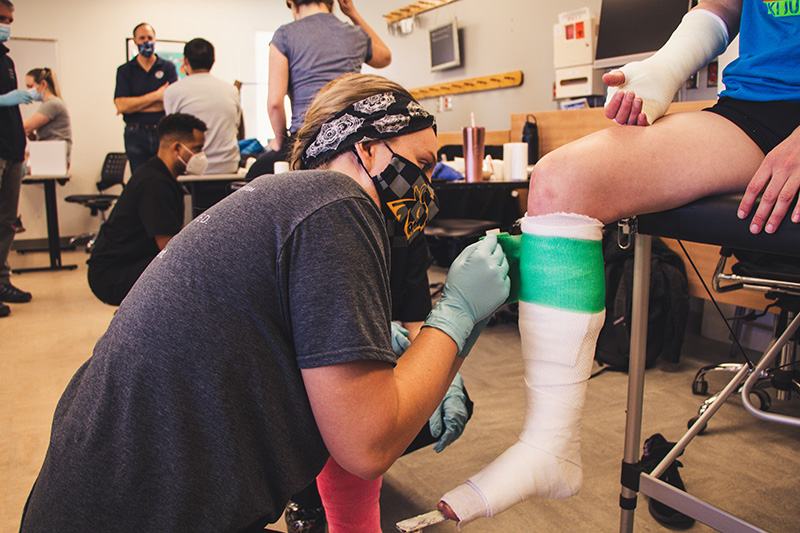Cross-disciplinary collaborations are beneficial for undergraduate students as well as those enrolled in master’s degrees. It’s embedded in the curriculum in almost every program on the Colorado Mesa University campus, and the health sciences are no different.
In March, students in the Master of Science in Athletic Training program teamed up with Master of Physician Assistant Studies Program students to learn together, but also to meet fellow Mavericks in other health-related fields. Nearly 40 students from the two programs participated in the casting clinic. They learned the ins and outs of how to cast different limbs and took turns training on one another.
“I didn’t know how to cast or splint anything before. I just kind of assumed you’d wrap something on and then you’re good to go. But you have to dunk it into water and mold it so the patient isn’t uncomfortable, and the foot has to be in the right position. I definitely learned a lot with this training,” said Katie Ivers, a first-year CMU athletic training student.
Ivers said as a future athletic trainer, learning the proper way to cast is a good tool to have under her belt and added that it was great getting to meet other people who are going into the medical field.
“As students, I think you get in your own little group with your class and people with your specific specialty. You don’t always get the chance to interact with others outside of your group, but in clinical practice that’s part of the job, so it prepares us for that,” said physician assistant student Tyler Anderson.
During an athletic event or sporting activity, athletic trainers are usually the first to see the patient and the first ones likely to splint the fracture. Once the patient arrives to the emergency room, an urgent care or to see an orthopedic, a PA would then process the patient, conduct the X-rays and get the surgical team involved if needed.
“We always want to have this casting clinic before they go on their rotations because they need to have the skills to be able to provide care pretty darn quick once they start,” said A'lanne Conrad, who is a CMU assistant professor of physician assistant studies and the director of assessment and evaluation.
According to Conrad, cross-collaborating with other programs is helpful for not only the students but local preceptors, who will work with the students during their clinical rotations.
“As long as they’ve [students] had the experience to see one, do one and, maybe even teach one, then they’ll be able to actually take charge and do what they need to do,” said Conrad.
The relationship between student and preceptor is that much stronger if the student comes in with the knowledge and skills needed to get the job done, and many of the students left the clinic feeling more confident in their skills and more connected to student’s outside their disciplines.
